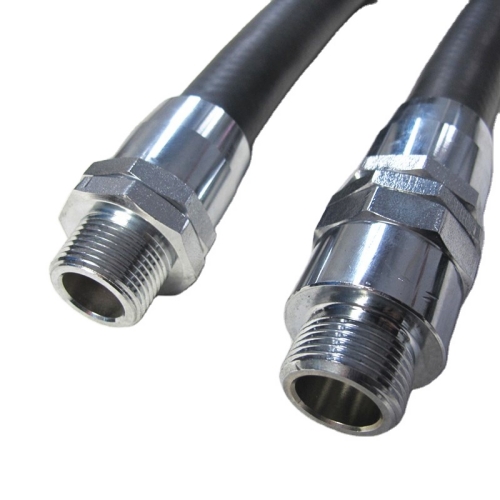335345435
Sep . 27, 2024 18:38 Back to list
hydraulic hose manufacturer factory
Understanding Hydraulic Hose Manufacturing A Deep Dive into the Industry
In the modern world, hydraulic systems play a crucial role across various industries, from construction and agriculture to manufacturing and automotive. At the heart of these systems lies a vital component the hydraulic hose. These hoses are engineered to transport hydraulic fluids safely and efficiently under pressure. The manufacturing of hydraulic hoses is a complex process that requires a thorough understanding of materials, design, and quality control.
What is a Hydraulic Hose?
A hydraulic hose is a tube designed to convey fluids, particularly hydraulic fluid, which is used to transfer power. Unlike regular hoses, hydraulic hoses must withstand high pressure, making the choice of materials and manufacturing techniques critical. These hoses typically consist of three main components an inner tube, a reinforcing layer, and an outer cover. The inner tube is responsible for containing the fluid, the reinforcing layer provides strength and flexibility, and the outer cover protects against environmental factors and wear.
The Manufacturing Process
The manufacturing of hydraulic hoses involves several key steps, each designed to ensure the final product meets strict industry standards.
1. Material Selection The first step in the manufacturing process is selecting appropriate materials. The inner tube is often made from synthetic rubber or thermoplastic, which can withstand high pressures and various chemicals. The reinforcement layer typically consists of steel wire or textile fibers, which provide the necessary strength. The outer cover is designed to resist abrasion, heat, and environmental effects, and is usually made from rubber or thermoplastic.
2. Extrusion Once the materials are chosen, the manufacturing begins with the extrusion process. The inner tube is extruded using a continuous process that shapes the raw material into a tube. This is typically done under high temperatures to ensure proper formation.
3. Reinforcement After creating the inner tube, the next step is to add the reinforcement layer. This can be done by spiraling or braiding steel wire around the tube to increase its strength. The method used for reinforcement depends on the intended application of the hydraulic hose and the pressure ratings it needs to meet.
hydraulic hose manufacturer factory

4. Outer Covering After reinforcement, an outer cover is applied. This can either be extruded or wrapped around the hose, providing additional protection. The outer cover is crucial for ensuring the longevity of the hose, especially in harsh environments.
5. Curing The next phase is the curing process, where the hose is subjected to heat to solidify the materials and bond the layers together. This process is essential for achieving the desired physical properties and ensuring durability.
6. Cutting and Coupling Once the hose has cured, it is cut to the required lengths. Couplings are then added to both ends of the hose. These couplings can be made from various materials such as steel or aluminum, and they ensure a secure connection to other hydraulic components.
7. Testing Quality control is a vital step in the manufacturing process. Each hose must undergo rigorous testing to ensure it can handle the specified pressures and is free from defects. Testing methods include hydraulic burst tests, impulse tests, and leakage tests. Only hoses that pass these tests are deemed ready for distribution.
Industry Standards and Compliance
Hydraulic hoses must meet various industry standards to ensure safety and reliability. Organizations such as the Society of Automotive Engineers (SAE) and the International Organization for Standardization (ISO) have established specific standards that hydraulic hoses must comply with. Manufacturers often seek certifications from these organizations to validate the quality and safety of their products.
The Future of Hydraulic Hose Manufacturing
As industries evolve, so too does the demand for innovative hydraulic hose designs and materials. Trends such as the adoption of lightweight materials, improved resistance to extreme temperatures, and enhanced flexibility are shaping the future of hydraulic hose manufacturing. Additionally, advancements in technology, including automation and the use of artificial intelligence, are streamlining manufacturing processes and improving quality control.
In conclusion, hydraulic hose manufacturing is a sophisticated process that plays an integral role in the functionality of hydraulic systems across various industries. By understanding the intricate steps involved in the manufacturing process, as well as the importance of quality and compliance with industry standards, we can appreciate the critical nature of hydraulic hoses in our daily lives. As manufacturers continue to innovate and adapt to emerging trends, the future of hydraulic hoses looks promising, ensuring that these essential components remain reliable and efficient in powering a wide range of applications.
-
SAE 100 R17 Black Smooth Cover Hydraulic Hose
NewsMar.07,2025
-
SAE 100 R17 Black Smooth Cover Hydraulic Hose
NewsMar.07,2025
-
SAE 100 R17 Black Smooth Cover Hydraulic Hose
NewsMar.07,2025
-
SAE 100 R17 Black Smooth Cover Hydraulic Hose
NewsMar.07,2025
-
SAE 100 R17 Black Smooth Cover Hydraulic Hose
NewsMar.07,2025
-
steel wire braided hydraulic hose
NewsMar.07,2025



